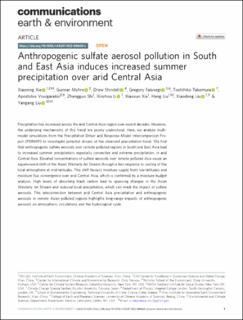| dc.contributor.author | Xie, Xiaoning | |
| dc.contributor.author | Myhre, Gunnar | |
| dc.contributor.author | Shindell, Drew | |
| dc.contributor.author | Faluvegi, Gregory | |
| dc.contributor.author | Takemura, Toshihiko | |
| dc.contributor.author | Voulgarakis, Apostolos | |
| dc.contributor.author | Shi, Zhengguo | |
| dc.contributor.author | Li, Xinzhou | |
| dc.contributor.author | Xie, Xiaoxun | |
| dc.contributor.author | Liu, Heng | |
| dc.contributor.author | Liu, Xiaodong | |
| dc.contributor.author | Liu, Yangang | |
| dc.date.accessioned | 2024-02-15T12:27:06Z | |
| dc.date.available | 2024-02-15T12:27:06Z | |
| dc.date.created | 2023-01-16T09:18:18Z | |
| dc.date.issued | 2022 | |
| dc.identifier.citation | Communications Earth & Environment. 2022, 3 (1), . | en_US |
| dc.identifier.issn | 2662-4435 | |
| dc.identifier.uri | https://hdl.handle.net/11250/3117976 | |
| dc.description.abstract | Precipitation has increased across the arid Central Asia region over recent decades. However, the underlying mechanisms of this trend are poorly understood. Here, we analyze multi-model simulations from the Precipitation Driver and Response Model Intercomparison Project (PDRMIP) to investigate potential drivers of the observed precipitation trend. We find that anthropogenic sulfate aerosols over remote polluted regions in South and East Asia lead to increased summer precipitation, especially convective and extreme precipitation, in arid Central Asia. Elevated concentrations of sulfate aerosols over remote polluted Asia cause an equatorward shift of the Asian Westerly Jet Stream through a fast response to cooling of the local atmosphere at mid-latitudes. This shift favours moisture supply from low-latitudes and moisture flux convergence over arid Central Asia, which is confirmed by a moisture budget analysis. High levels of absorbing black carbon lead to opposing changes in the Asian Westerly Jet Stream and reduced local precipitation, which can mask the impact of sulfate aerosols. This teleconnection between arid Central Asia precipitation and anthropogenic aerosols in remote Asian polluted regions highlights long-range impacts of anthropogenic aerosols on atmospheric circulations and the hydrological cycle. | en_US |
| dc.language.iso | eng | en_US |
| dc.publisher | Springer Nature ltd | en_US |
| dc.rights | Navngivelse 4.0 Internasjonal | * |
| dc.rights.uri | http://creativecommons.org/licenses/by/4.0/deed.no | * |
| dc.title | Anthropogenic sulfate aerosol pollution in South and East Asia induces increased summer precipitation over arid Central Asia | en_US |
| dc.title.alternative | Anthropogenic sulfate aerosol pollution in South and East Asia induces increased summer precipitation over arid Central Asia | en_US |
| dc.type | Peer reviewed | en_US |
| dc.type | Journal article | en_US |
| dc.description.version | publishedVersion | en_US |
| dc.source.pagenumber | 0 | en_US |
| dc.source.volume | 3 | en_US |
| dc.source.journal | Communications Earth & Environment | en_US |
| dc.source.issue | 1 | en_US |
| dc.identifier.doi | 10.1038/s43247-022-00660-x | |
| dc.identifier.cristin | 2107363 | |
| cristin.ispublished | true | |
| cristin.fulltext | original | |
| cristin.qualitycode | 1 | |

